|
G |
Gabilahnis a manufacturer of a warangka in Madura im Gayaman Madara style. |
Gada Tapan, Kanjeng Kyaiis a Pusaka Tombak from Keraton Yogyakarta. It comes from the Dapur Gada, this Dapur is actually quite unknown. |
Gada Wahana, Kanjeng Kyaiis a Pusaka Tombak from Keraton Yogyakarta. It comes from the Dapur Gada, this Dapur is actually quite unknown. It was a gift to Sri Sultan Hamengku Buwono III. |
Gadingis the Indonesian word for ivory. It is used to build a warangka or a handle. Originally this ivory is from the tusks of an elephant. The tusks of an African elephant are up to 160 cm long, and up to 125 cm long at the Asian elephant. The weight is 25 kg and 18 kg. One uses ivory of elephants in Sumatra. Meanwhile, it is hard to come by and very expensive for buying ancient ivory. In 1993 they paid 225,000 rupiah for 1 kg Sumatra ivory and 140,000 rupiah for 1 kg of African ivory, now there are 6,000,000 rupiah (approx. EUR 00) for good ivory. Many keris experts wanted earlier no warangka made of ivory because it is a very hard material and they were afraid that it will damage the blade and pamor. Therefore only Keris were stored with evil magical force in Ivory warangka or from people who do not understand the world of keris. With a handle that was never a problem, because it is not directly connected to the blade. There are other Gading species used as only the elephant, e. g. walrus and seal. Keris experts believe that the teeth of a manatee exert positive magical powers. On Bali, Palembang and Jambi Ivory handles were certainly plentiful and are very important since timmemorial time. |
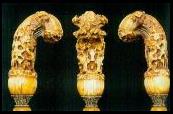
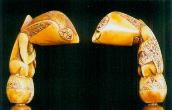
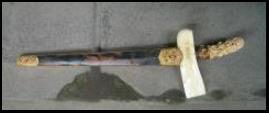
|
Donoriko Madura |
|
Jawa Demam |
|
Keris Bali |
Gajah Gelaris a pamor please read more here. |
Gajah Singais the name for an ornament in Kinatah Gold, which is attached to the underside of the Ganja. It represents an elephant (Gajah) and a lion (Singa) and they are separated by the Pesi of a Keris. This is a sign of respect for the blade of a keris and aid acquis. They are mounted since the age Sultan Agung. |



Gajangis the name for a Keris in Bugis and Makassar. |
Galais a traditional weapon in spear shape of Flores, East Nusa Tenggara. Like a Tombak in Java the spear is completed by a tip made of wrought iron. The Gala is 170 to 210 cm long, including the spearhead. In Flores and around the weapon is used for hunting deer and wild boar. |
Gana Kikiksee Naga Kikik |
Gandaris part of the warangka of a Keris. If a pendok is used the wood of the gandar is not very hard. The shape is round, long and thin. Its purpose is that the keris is tight. The peak is called Antup-Antupan. This serves to vent the Keris, so that the blade will not rust. In a gandar Iras is the wood of a warangka one piece with the warangka. So one must have a gandar pendok namely a pendok blewahan so you can also see that there is gandar Iras. In North Sumatra, Riau, West Borneo and Malaysia a gandar is called sarung keris. The Awak-Awak is known there as Sampir. |


Gandar Irasis part of the Warangka, the gandar is made of one piece of wood as the warangka. Keris with gandar Iras are more expensive than normal Keris. The reason is that the timber must have better quality and is difficult to find. |
|
Gandawisa, Kanjeng Kyai is a Pusaka Keris, which belongs to the Kraton Yogyakarta. It has the Dapur Naga Siluman with the warangka made of Trembalo wood. It was made by Panembahan Mangkurat the reign of Sri Sultan Hamengku Buwono V. |
|
Gandek or Ri Pandan is a part below the warangka, see also warangka. |
|
Gandik is a part of the blade of a keris. There is a simple Gandik and there are others that are followed by other ricikan. At the top is the Sirah Cecak. It is normally located always at the front, just in Dapur Cengkrong and Carubuk behind. The term comes from the Javanese language and means as much as mortar. At the Gandik you can find the following Ricikan: Kembang Kacang, Jalen, Lambe Gajah, Jalu Memet. A long Gandik have Dapur Mahesa Lajer, Mahesa Teki and others. There are also some krisses with two Gandik (front and rear). Some krisses have a Gandik, which have the shape of a dragon's head, lion, Putut, elephant, peacock, frog, dog etc. in miniature. |

|
f.l.t.r.: normal Gandik, large Gandik, Gandik at the rear |
|
You can many kinds of a gandik see here: Gandik Keris Bali and Gandik Keris Java. |
|
Gandrung, Pelet Is a motif of a warangka made of timoho wood, which has large spots. Many keris experts mean that this has a great and might power. |
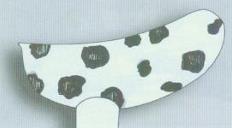
|
Ganggeng Kanyut is a pamor motif and belongs to Pamor Miring. You can read more here. |
|
Ganja is a part at the bottom of the blade. In the middle of the Ganja is a hole for the Pesi. Read more about ganja here. |



|
Ganja Iras Just as a gandar Iras for a Warangka (in one piece), there are at the Ganja also Ganja Iras. Thise can be found, however, only for keris Sajen. This krisses, consisting entirely of metal, not only the blade but also the handle. |
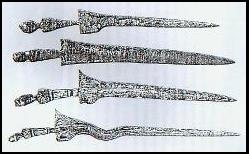
|
Ganja Kendit Mimang is a Ganja with pamor in the form of a line, which runs the entire length of the Ganja along. Some kriss experts believe this Ganja has the magic power to protect the acquis before the disturbances by thieves. So you can use it to protect the house with this Ganja also. |

|
Ganja Sampir is a Ganja with pamor in the form of a line running across the Ganja. This line can be straight, oblique, thick and thin. Keris experts believe that the possession of these Ganja has the magical power to increase the property. Managers believe that employees meet their specific tasks better. Therefore, one should have this Ganja when still standing at work and does not receive a pension. |

|
Ganja Sekar see Ganja Wulung |
|
Ganja Susulan is a kind of a Ganja. |
|
Ganja Wulung is a Ganja without pamor. There are many krisses with good pamor that have this pamor-less Ganja. In the world of krisses on Java and Madura is a Ganja with pamor Ganja Sekar. There are many opinions why ganja is without pamor, it should be designed with a good blade with a duplicate of the Ganja without pamor or that the keris was broken and the ganja is lost etc. |
|
Gapit is part of a thin tombak. The operation is similar to the Ada-Ada of a keris. An Ada-Ada can go to the tip of the blade, the Gapit but only 3/4 of the blade‘s length. The Gapit is also greater than the Ada-Ada, about the size of a pencil. For example the Dapur Sapit Abon has a Gapit. |

|
Gardner, G.B. is the author of the book Keris and other Malay Weapons, published 1936 in Singapur. |




